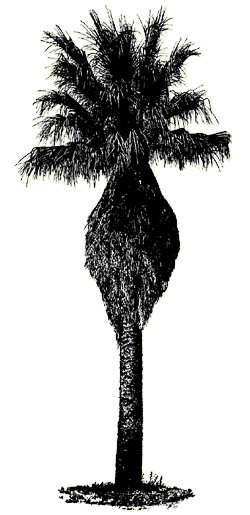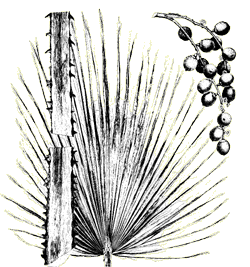Aracaceae (Palmae) (palm family)
Palms are among the most distinctive plant life forms and thus scarcely need description. Virtually all of the more than 2600 species in the world are instantly recognizable as palms, and only the unrelated cycads and another small family of tropical plants might confuse a nonbotanist. Because of their high recognition they’re widely used in all kinds of media—in movie sets to landscape designs and cartoons—to represent a tropical setting or, in stark contrast, a desert oasis.
Palms are indeed tropical plants. Almost all species are native to tropical forests and very few can tolerate frost or dry soil. The existence of palms in the Sonoran Desert is one of many indications of its tropical connection.
Washingtonia filifera
English name: California fan palm, Washington palm
Spanish names: palma de Castilla, palma de abanico (fan palm)
Washingtonia robusta
English names: Mexican fan palm,
skyduster palm
Spanish names: palma colorada
(red-brown palm), palma blanca (white palm), palma de Castilla
Descriptions
Washingtonia filifera has a very thick trunk and grows slowly to about 45 feet (14 m) tall. Washingtonia robusta has a thin trunk, but grows rapidly to twice as tall. Both species have large, palmate leaves with spiny petioles clustered at the top of the trunk. (A petiole is the stalk that connects the leaf to the stem.) Dead leaves hang vertically and form a persistent skirt around the trunk. Inflorescences extend beyond the leaves and bear masses of tiny white to cream-colored flowers. During the fall months, large clusters of small, hard fruit hang from the tree. The palms may live 150 to 200 years.
 |
Range
Washingtonia filifera occurs naturally in about 70 desert oases, most in southeastern California and northern Baja California. A few groves occur in Arizona, all but one of which are close to the Colorado River. Washingtonia robusta is found in similar habitat in northern Baja California, and there are a few populations on the coast of Sonora near Guaymas.
Notes
Both Washington palms require a constant source of water and, because they lack deep roots, they can grow only where water is near the surface. Nonetheless these are true desert plants, because an oasis is a desert environment. (Water sources in other habitats are not properly called oases.) These palms will die if the temperature is below freezing for more than 24 hours, but they can survive a few hours near 15°F (-10°C). In the Coachella Valley of California, numerous palm oases occur in a nearly straight line along the San Andreas fault, which forces subterranean water to the surface.
 |
The fruit is produced in huge bunches; each one has a thin, but sweet, layer of pulp covering the large seed. The fruits are eaten by coyotes and were also harvested by native Americans. Both species dispersed the seeds from canyon to canyon, establishing many of the genetically uniform populations throughout the species’ ranges.
The giant palm borer (Dinapate wrighti) is a thumb-sized beetle (to 2 inches; 52 mm) long. It belongs to the family of branch and twig borers (Bostrichidae), and is by far its largest member. Adults fly during the hottest summer nights, mate, and lay eggs in a California fan palm crown. The grubs feed on the fibrous trunk tissue with their large mandibles. During their 3 to perhaps 10 year larval life they burrow down the trunk nearly to the ground, then part-way back up before pupating. Heavily-infested trees can snap in strong winds. Commercial transport of palms has spread the borer to the urban oases of Las Vegas and Phoenix where they now infest date palms (Phoenix spp.) as well.
The persistent skirts of dried leaves that clothe the trunks provide shelter for a myriad of wildlife species. Orioles have a particular affinity for nesting among the leaves. Paper wasps (Vespidae) and bees often nest there too. Multitudes of scorpions and spiders can be found living in the thatch; lizards prey on the invertebrates and hide from their predators under the skirts.
Many wild palms lack skirts because vandals set fire to them. The trees themselves are fire-resistant, but the destruction of the thatch ruins much of the palms’ value as wildlife habitat. There may be a benefit, how-ever, in the reduction of palm borer populations. Cultivated palms are usually trimmed of their dead leaves to “improve”their appearance (a matter of taste), or to eliminate habitat for insects and rodents, which are perceived as nuisances. The wasps, at least, are beneficial as predators on many garden pests and are rarely aggressive towards humans (except those trimming the palms).
Wherever palms grow, their leaves may be used for making thatched roofs. The large broad leaves can easily be made into a rainproof shelter that will last for several years. Palm-thatched houses are fairly common in southern Sonora outside the desert. Leaves from natural and cultivated populations are transported to resorts on the desert coast to cover palapas (beach shelters). The trunks are used to make corrals and fences.
These palms are uncommon in nature, but there are millions of them in landscapes all over the warm-temperate world. Washingtonia robusta is the palm planted so abundantly in Southern California that it has become a symbol for that region, even though it is not native there. Warren Jones, one of the founding fathers of desert landscape architecture, says they are the Sonoran Desert’s greatest contribution to ornamental horticulture.
Brahea spp.
English names: blue palm,
hesper palm
Spanish names: palma azul (blue palm), palma ceniza (ashy palm)
Description
Several species of fan (palmate-leafed) palms occur in desert oases and wet tropical canyons in the Sonoran Desert region. They resemble the Washington palms except that they are smaller in stature and most have gray-green to blue-green foliage. Brahea armata in Baja California is the bluest; it creates an extraordinary sight in nature, where it is often found among white granite boulders with boojums and elephant trees (see Plate 27), or in designed landscapes. It is uncommon in cultivation because it’s very slow growing.
Range
Brahea armata grows in desert oases in north-central Baja California. Other species occur in oases in Sonora and in tropical deciduous forest.










